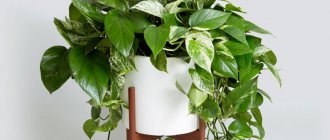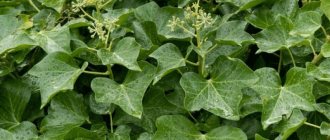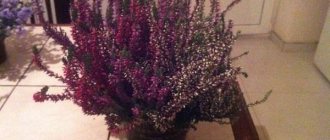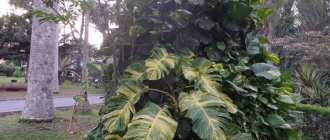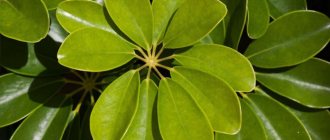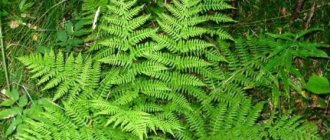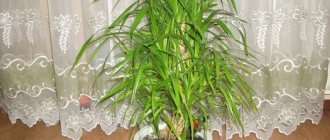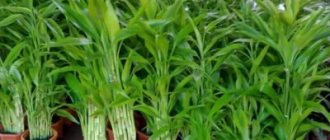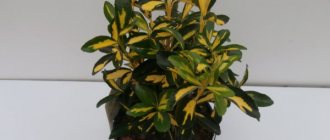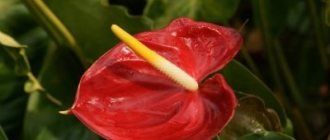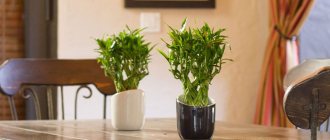Scindapsus is a flower whose second name is epipremnum. It originally grew in Southeast Asia, Africa, and Polynesia, from where it was distributed throughout the world. In open ground, the bush actively spreads along the ground, reaching 15 m in height. At home, its size is much smaller. People also call the flower by other names, for example, devil's ivy, devil's ivy. Decorative foliage plants do not require careful care; it is enough to follow the basic rules. Then the evergreen epipremnum will delight the owner for a long time.
Description
The scindapsus flower is characterized by the following qualities:
- a perennial evergreen species that actively grows on other trees that act as a support;
- divided into 30 species, but only a few of them are grown at home;
- many species were developed through selection and hybridization;
- the leaves are oval with a sharp tip, have a variety of colors, may have spots or streaks, and contain a large vein in the center;
- flowers are observed only during natural growth; large ears with a veil are formed;
- domestic varieties do not bloom, so the decorative effect is based only on vines containing leaf blades;
- the flower is placed in hanging pots, next to which supports are installed to support the vine;
- to achieve a large, lush epipremnum, 2-4 cuttings are placed in a pot at once.
The scindapsus liana has several types of roots:
- air, attached to a support;
- air, designed to produce oxygen;
- underground.
Many novice gardeners are trying to figure out the differences between scindapsus and epipremnum. In fact, they are the same flower with different names.
Types and varieties
There is a wide variety of types of this flower: Imperial White, Regina Red, Brown Aron, Pink Chocolate, Jade, Red Spot, Godzilla and many others. But for growing indoors, the following types are most often used:
- golden;
- painted.
Golden
The most common variety, distinguished by the fact that golden spots are scattered on the leaves. The light creates a feeling of shimmering yellow, green, and gold; it’s not for nothing that it’s called “golden lotus” among lovers. Unpretentious, but more prone to disease than other species.
Has varieties:
- Marble Queen - variegated silver-green, similar to marble;
- Golden Queen - green leaf with random yellow spots;
- Neon - bright lemon color;
- N-Joy is a new Dutch variety, smaller than the others, with thick stems and tough, dense leaves with large white sinuous spots, usually closer to the edge.
Painted (pictus)
Variegated appearance, leaves are more oval, dark green with various white and silver inclusions. Quite resistant to diseases and pests. There are small growths on the stem - aerial roots; over time they turn brown and help the plant become more tenacious and collect moisture from the surrounding atmosphere.
Varieties:
- Exotic - large-leaved, stands out due to the curvature of the leaves, convex veins and silvery chaotic dots and strokes;
- Trebi - unlike others, tolerates shaded areas better;
- Arguraes - with a white edge along the edge of the sheet and scattered silver-colored spots.
Useful properties of scindapsus
Many gardeners grow indoor scindapsus, as it has a variety of useful qualities:
- decorative properties, decoration of home rooms;
- air purification due to the active process of photosynthesis;
- indoor air humidification;
- elimination of harmful electromagnetic waves emanating from household appliances;
- antiseptic effect to destroy fungi and bacteria living in the air.
In addition to a lot of useful properties, the epipremnum flower fits beautifully into any interior. It does not require careful care and grows quickly if the growing rules are followed.
Is it possible to keep scindapsus at home?
Devil's ivy scares those who want to purchase a tropical vine to grow in an apartment. There is an opinion that scindapsus brings misfortune. Both good and bad omens are associated with it. It is believed that the plant should not be kept at home, not only because of the poisonous foliage, but also because the flower can bring disaster to the inhabitants of the house.
The plant, despite its toxicity, is considered very useful. It neutralizes formaldehyde, xylene, ammonia and other harmful substances contained in the air, so scindapsus is kept in the house, even despite the signs and superstitions associated with it. The flower produces an increased amount of phytoncides, which help to breathe freely. It is readily installed in public places - hospitals, waiting rooms.
Before purchasing devil's ivy for your apartment, think about whether you can protect it from the encroachment of children and pets. Don’t forget about your safety: all manipulations with the plant should be carried out with gloves. Anyone who decides to have a dangerous vine at home will be rewarded with clean air and a positive magical effect. To understand whether a flower will be useful for you, listen to popular beliefs.
Types with photos and names
A wide variety of Scindapsus species have been identified. But 4 of them are often grown indoors. All types and varieties are similar to each other, differ in the color of the leaf plates and the height of growth. There is a wide variety, for example, scindapsus joy or enjoy, trebi, pothos, argureus, marble, silver. But not all of them are grown at home. More often, flower growers prefer varieties that do not require careful care and do not lose their decorative properties.
Siamese scindapsus (Scindapsus siamense)
Scindapsus siamese photo
Scindapsus siamese has the following differences from other varieties:
- asymmetrical sheet plates;
- large sizes of green sheets on which spots, stripes, streaks with other shades (yellow, silver, light green) are localized;
- The liana originally grew in southeast Asia, from where it was transported to Europe.
There are rare species of Siamese scindapsus, which are of great value and are found only in some gardeners:
- troyba - has large leaves with a sharp edge, grows extremely slowly;
- perakensis - green leaf plates with a uniform structure, growing in the shape of an arrow, with leaf appendages in the form of wings.
Signs based on the type of flower
There are about 35 varieties of this vine. In some cases, the interpretation of a sign depends on the specific type of flower. Most of the superstitions are associated with the golden scindapsus - not only the most beautiful, but also the most poisonous of all species. Flower growers do not advise keeping it where there are birds and pets.
The following signs are associated with lesser-known varieties:
- Neon is a tropical vine that activates creative energy and awakens the vitality of people living under the same roof. Helps you make decisions and act actively in any situation.
- Picus - creates a creative atmosphere in the house, puts you in a businesslike mood. It is recommended to keep it in offices to improve productivity and concentration of employees.
- Enjoy is a vibrant decorative vine that awakens creativity and out-of-the-box thinking.
- Siamese ivy helps to reveal romantic feelings, has a calming effect on others, and helps to cope with various difficulties and obstacles in life.
- Golden ivy promotes wealth and financial independence.
All types of plants create a cozy atmosphere in the house and contribute to a surge of creative energy. In some cases, the liana promotes happiness in the home and the development of children's mental abilities. Devil's ivy is readily purchased, despite the negative signs associated with this flower.
Caring for scindapsus at home
Home care involves choosing the right location, quality temperature, humidity, soil, and watering. Be sure to add fertilizing. If all requirements are met correctly, growth will be abundant and diseases will not occur.
Illumination
Scindapsus in a pot
To stimulate photosynthesis in the leaf blades, abundant sunlight is required, but the rays should not spread directly. Otherwise, it will lead to burns and deterioration of decorative properties. If there is not enough light, the leaves will fall off, exposing the shoots. Therefore, it is recommended to place the bush according to the rules of care:
- installation on windows on the south-east or south-west side;
- prohibition on location from the north or south, this equally negatively affects growth;
- if the epiprenum cannot be hidden from direct sunlight, install blinds or curtains with a translucent texture.
It is better not to place the flower on the windowsill; it should be 1-1.5 m from the window. This will protect him from burns, but will maintain the flow of light. If growth is observed in a cloudy area, you can use a phytolamp for additional lighting. The total daylight hours should be 10-12 hours.
Temperature
Scindapsus loves warm temperatures, but it should not be too hot, otherwise moisture will evaporate from the surface of the leaves and they will become lethargic. The following recommendations for temperature care are distinguished:
- period of active growth in spring and summer – 18-25 degrees;
- the rest period in autumn and winter is 18-20 degrees.
In summer, the temperature should not rise above 25 degrees. If this happens, abundant moisture and frequent ventilation of home rooms is required. In winter, when caring, you can only slightly reduce the temperature, but below 16 degrees is not recommended. Life processes in the epipremnum will slow down, the vegetative mass will become sluggish.
Air humidity
If a grower wants to achieve elasticity and good shape of the vegetative mass of scindapsus, it is necessary to maintain the humidity at 60-70%. To accomplish this, different methods of moisturizing are used, each of which is recommended in a certain season:
- in spring and summer - spraying scindapsus with filtered water from a spray bottle, placing a tray with liquid under the flower, wiping the leaf plates with a damp sponge;
- autumn, winter - turn on the humidifier only if the heating devices start working, the rooms become too stuffy.
The benefits and harms of the plant
The stumbling block between fans of the exotic vine and its opponents is the question of its benefits and harms. An unpretentious, rapidly growing plant is not only a means of decorating rooms and recreation areas, but also an excellent producer of phytoncides. The climbing plant effectively purifies the air in a closed space from the following toxic compounds:
- formaldehyde;
- xylene;
- carbon monoxide;
- benzene;
- toluene;
- ammonia;
- carbon dioxide.
The phytoncides secreted by scindapsus help disinfect the home microclimate . However, this is where the positive properties of the vine end. The plant, called golden ivy, is poisonous.
Its juice can corrode the skin and cause allergic reactions in both humans and animals. Therefore, agricultural technology should be carried out using protection methods. At the same time, it is necessary to take care of the safety of pets, children and other family members.
Reproduction of scindapsus
To propagate a home bush, there are 2 methods - cuttings and layering. This will allow you to quickly grow epiprenium and achieve the propagation of a healthy culture. It is necessary to follow all the rules of reproduction and care at home so that the procedure does not cause the death of the mother. It is better to propagate scindapsus in early spring before active growth, so as not to slow down growth.
Cuttings
Epiprenium cuttings are obtained through the pruning process. Cut off a healthy vine that has no damage. The cut areas are treated with charcoal to prevent the formation of an infectious focus there. Further propagation of scindapsus by cuttings is carried out in stages:
- the cutting is placed in water, where a little Epin or Kornevin is added, which stimulate root growth;
- the water is changed periodically so that the shoot does not begin to rot;
- As soon as a root has formed, it is transplanted into an individual pot with a nutrient mixture.
Instead of water, you can immediately use nutritious soil consisting of peat and sand. Then the root growth stimulator is applied directly to the tip of the plant. Install plastic film to create greenhouse conditions; the temperature should be maintained at 20-22 degrees. Transplantation is carried out when growth has appeared, which means root formation.
Reproduction methods
Most often, golden pothos is propagated by apical or stem cuttings. They should have at least a couple of leaves. There are two ways to root cuttings:
- in a glass of water;
- in the soil mixture.
In the first case, the cuttings cut at an angle have to be transplanted into the soil after the roots appear on it. At the same time, the process of obtaining a full-fledged plant is delayed.
In the second case, the prepared shoot is planted in a nutrient mixture of moss, sand and peat. Before this, it is kept in a “Stimulin” solution, and then the cut is dried and treated with crushed charcoal.
The best conditions for keeping a seedling are warmth (temperature of at least two tens of degrees), diffused light and moisture. He also needs a mini-greenhouse made from a transparent container . In this case, it is necessary to spray and ventilate the plant. The process of adaptation and the appearance of roots lasts several weeks. Then you can transplant the strengthened seedling with a lump of earth into a separate pot, where you can no longer create greenhouse conditions for it.
A less common method of propagating pictus is the so-called “pinning” of branches. In this case, the young shoot is bent to the ground and secured in this position with wire. After roots appear on it, the shoot can be separated from the main flower and transplanted with a lump of earth into a separate pot.
Possible problems during cultivation
If the grower is inexperienced, problems may arise in the process of caring for and growing a home bush:
- falling leaves - lack of moisture or fertilizer, location of the scindapsus in the path of a draft;
- drying of the tips of the leaf blades - insufficient watering or humidity in the room;
- slow growth - lack of fertilizers or lack of replanting, which causes soil depletion;
- brown, black spots - excessive watering, which causes abundant proliferation of fungi, especially if the temperature in the room is low.
If you normalize all the rules of care, the problem will quickly disappear. But in advanced situations, the bush may die completely.
Differences between scindapsus and epipremnum
Scindapsus and Epipremnum have similar biological characteristics and belong to the same Araceae family. It is very difficult to distinguish plants from each other; they are distinguished by the number of seeds formed. Many species that formerly belonged to the genus Scindapsus are today considered epipremnums.
For example, the golden scindapsus is today called epipremnum aureus, but both names are considered synonyms. The literature often contains conflicting information regarding species, which is explained by the similarity of aroid vines. But plants also differ in small, subtle details.
Epipremnum aureus
Golden epipremnum differs from painted scindapsus in being more resistant to low temperatures. Previously, this variety was considered a greenhouse plant. Epipremnum can easily tolerate a decrease in temperature to 10-12˚С, and painted scindapsus begins to die if the temperature drops below 15˚С.
The main difference between epipremnum and scindapsus is the shape of the leaf blade. If the first ones are characterized by a symmetrical leaf, then the second vine has curved leaves that resemble a comma.
The principles of growing both vines are almost the same, so they need to be bred according to the same algorithm.
Diseases and pests
In scindapsus, diseases develop if improper care is taken. It is important to identify deviations in a timely manner in order to carry out treatment correctly.
- Black spots on leaves. The problem is overwatering. It is necessary to replant the bush, cutting off all the rot on the roots. Additionally, the plant is treated with a fungicidal preparation to reduce the growth of fungi.
- Dried tips of leaves. Epiprenum is located near heating devices, so it begins to dry out quickly. It accelerates if watering is insufficient. You need to turn on the humidifier and frequently spray the leaves with a spray bottle.
- Massive leaf fall. It develops due to strong drafts or insufficient sunlight. The homemade scindapsus bush is installed in a new location where there is more sunlight.
- Loss of leaf variegation. It develops due to lack of lighting. You need to place the bush on the southwest and southeast sides or use a phytolamp.
- Rolling the tips of the leaves into a tube. The florist uses low-quality water. It contains many salts and chemical components that negatively affect the plant mass. Pre-filtration or boiling is required.
- Increasing the distance between sheet plates. The florist uses organic fertilizers that are aimed at the appearance of flowers. Mineral preparations are used, diluting the required concentration by 2 times.
When caring for epiprenum, one should not forget about lighting, watering, and fertilizing. All these points must be followed according to the rules, without overdoing it.
In addition to various diseases, scindapsus may develop pests. Insects often migrate from other species or when a home flower is placed outside in the summer. The following insects are dangerous to epiprenum:
- aphids are small white insects that form holes or yellow spots on leaves;
- mealybug - leads to the formation of round white growths, shaped like cotton wool;
- spider mite - the formation of small cobwebs between the stems.
For treatment, the bush is initially treated with a solution of laundry soap. This will help remove most insects and wash them off the surface. Then an insecticide is applied that kills most pests. Its concentration is calculated according to the instructions. Treatment is continued for at least a week to destroy all eggs and larvae, otherwise a relapse will occur.
Scindapsus is an exotic plant that is currently used for home cultivation. If you properly care for it, problems and diseases will not arise. All the gardener needs to do is select the variety he likes, water, replant, and fertilize.
Folk signs and superstitions
The undesirability of this climbing plant in the house comes from ancient times. There is a legend that this is the work of Hera, the wife of the thunderer Zeus. After the miraculous rescue of a boy by ivy, adopted by the formidable God on the side, she hated this plant, forbidding it to be grown anywhere.
The bad reputation that was once created still haunts the flower. Many are confident in its negative energy, which can only bring trouble:
- family quarrel;
- discord between the bride and groom;
- serious illness or grief.
No one can predict where the consequences of her stay in the home will turn. There is no evidence of bad omens.
Remember one thing - the low-maintenance scindapsus will fully thank you for proper attention to it. And for this it is enough:
- when planting, use ordinary universal soil;
- choose a location in a slightly shaded corner of the room, away from heating appliances;
- protect the flower from drafts;
- maintain the optimal temperature in the room +180C;
- Regularly carry out moderate watering with slightly warm water.
Rules of care
Scindapsus is undemanding in care, but for good growth and beautiful leaves you need to follow simple rules.
Lighting
What the liana does not like is direct sunlight. It can grow in the shade, but with a lack of lighting, the variegated leaves lose their decorative effect and become smaller. With a catastrophic lack of light, the vine begins to lose leaves, which exposes the shoots and can lead to the death of the plant. Traditionally, scindapsus is placed in a hanging pot on the wall. With this arrangement, it is easier to choose a place with the right lighting. If the window faces south, then it is recommended to place the pot with scindapsus at a distance of one and a half to two meters from the window. When placed in the shade, artificial lighting can be provided.
Temperature
The liana grows well in a wide temperature range from eighteen to twenty-five degrees. If the temperature in summer exceeds the specified value, then it is necessary to humidify the air, otherwise the leaves will begin to fall off. In the cold season, the temperature should not drop below sixteen degrees. The liana can withstand a short-term decrease of up to twelve degrees, but it is better not to allow this.
Watering and humidity
In summer, scindapsus needs regular and frequent watering. But at the same time, the top layer of soil should dry to a depth of two to three centimeters before the next watering. Water with plenty of settled water at room temperature. After half an hour, excess water is drained from the pan to avoid stagnation of water and rotting of the roots.
Since scindapsus is native to tropical forests with high humidity, it is recommended to increase the humidity by daily spraying in the summer and less frequently in the winter, during heating operation. It is recommended to wipe the leaves with a damp sponge or shower in the summer. But showering is difficult for plants with long shoots located on the wall. Another method of hydration is proposed for them. The liana is initially planted in a clay pot, which is distinguished by its ability to absorb moisture. The pot is wrapped in sphagnum moss and placed in a larger wall planter. By keeping the moss moist, without standing water, you can increase the humidity around the vine. In winter, it is necessary to place scindapsus away from heating radiators.
Top dressing
To feed scindapsus, mineral fertilizers for decorative deciduous plants are used. Fertilizer application frequency:
- from spring to autumn - once every two weeks;
- in winter - once every month.
This may be interesting: Yucca - reproduction, diseases and pests
Bush formation
The formation of the scindapsus crown has its own characteristics. The shoots of the vine grow quickly, so it is recommended to prune them in the spring. Although such a procedure will not lead to the formation of side shoots or the formation of new ones. To obtain a dense bush, several cuttings are planted in one pot.
To add decorativeness, supports of various shapes are used: arches, ladders, wire or rope fastenings. Young shoots are directed along them, which are attached to the support by aerial roots. It is not recommended to disturb old shoots by moving them from place to place. This can lead to damage to the shoots and the need to prune them.
Transfer
Young plants are transplanted in the spring for the first three years. The diameter of the new pot should be three to four cm larger than the old one. The size of the scindapsus is suitable for a shallow, wide pot in which several cuttings can be planted. If the plant is older than three years, then replanting is carried out once every three years. If the plant has grown long shoots and you do not plan to trim them, then it is better not to disturb the vine unless necessary. Otherwise, the fragile shoots break off during transplantation, and the vine loses its decorative effect.
Good to know! To speed up root growth and get a plant with a powerful root system, it is recommended to shorten the roots by one third during replanting. The cut areas are sprinkled with crushed activated carbon.
The soil
The decorative vine grows well in loose, light soil. To prepare it yourself, you will need to mix the following ingredients in equal parts:
- turf land;
- leaf soil;
- peat;
- sand.
To add additional looseness, perlite or fine expanded clay and crushed pine bark are added to the mixture. In terms of acidity, the soil should be slightly acidic.
For planting scindapsus, a ready-made earthen mixture for decorative foliage plants is suitable.

